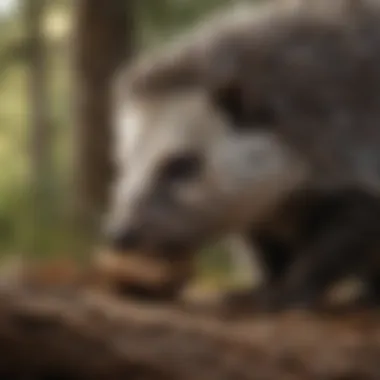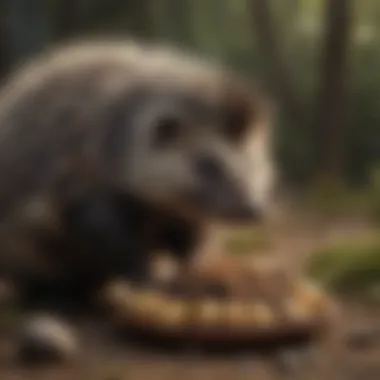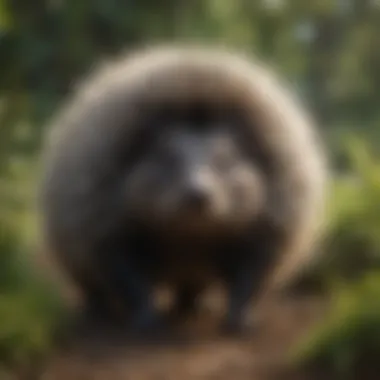Exploring the Intricacies of the Porcupine Diet


Intro
Porcupines are intriguing creatures with a diet that is both complex and fascinating. Understanding their dietary habits is crucial not just for academic exploration but also for appreciating their role in ecosystems. Their nutrition choices correlate strongly with their health, behavior, and environment. Through this examination, readers can gain valuable insights not only into porcupine physiology but also their place in the ecological tapestry where they dwell.
Animal Species Profile
Prolusion to the animal species
Porcupines belong to the family Erethizontidae and traditional names are often misleading. Despite some confusion related to their name, porcupines are distinct from rodents in significant ways, primarily in behavior and habitat preference. The two major groups are the New World porcupines found in North America, and the Old World porcupines located in African and Eurasian regions.
Physical characteristics and appearance
Porcupines are characterized primarily by their quills. These are not just ordinary hairs but modified, barbed structures that provide defense mechanisms against potential predators. The size of a porcupine can generally range between 20 to 36 inches, and they weigh an average of 10 to 35 pounds. The color palette can vary widely, so some can be dark brown, while others may flaunt lighter shades.
Natural habitat and distribution
Porcupines thrive in diverse habitats. They inhabit forests, grasslands, and deserts. Favoring tree-dense environments, they are semi-arboreal animals and often climb trees to access food. In North America, you can find them ranging from southern Canada to northern Mexico.
Behavior and social interactions
Porcupines are primarily nocturnal, which means they are active during the night. They tend to be solitary creatures, especially when foraging for food. Despite their somewhat lonely nature, porcupines can be spotted communicating with each other through various vocal cues.
Conservation & Wildlife Efforts
Overview of conservation status
Most porcupine species are not considered endangered, but local populations could be affected by habitat loss or human interaction.
Threats to the species
Critical threats include large-scale deforestation, leading to habitat destruction. Road accidents also pose significant risks to porcupines, especially in areas near urbanization.
Conservation initiatives and organizations
Efforts for conservation often focus on habitat protection and restoration. Organizations work towards awareness programs to enlighten the public about the importance of preserving porcupine habitats.
Success stories and impact
In certain regions, porcupine populations have displayed remarkable resilience. Through effective conservation strategies, some areas noted stable or increasing porcupine numbers. This rebound suggests that focused conservation can yield positive results for wildlife.
Animal Behavior & Psychology
Communication and language cues
Porcupines communicate using various sounds like quills rattling or soft vocalizations. These methods may alert other porcupines to their presence or to determine dominance.
Reproductive behavior and parenting
The mating season spans spring and summer. After a gestation period of about 7 months, females usually give birth to a single porcupette, which is dependent on the mother for initial survival.


Cognitive abilities and problem-solving skills
Studies suggest that porcupines showcase significant intelligence by assessing their environment carefully and problem-solving to access food, showcasing their adaptability.
Emotional intelligence and social dynamics
While porcupines are not highly social, they navigate their social lives through visual and audible displays. They can display varying degrees of maternal affection towards their young, solidifying their place in complex animal family dynamics.
Unique Facts & Trivia
Little-known facts about the animal
Porcupines have the ability to consume up to 20% of their body weight daily. They prefer plants that are high in fiber, often munching on hardwood, bark, and leaves.
Surprising behaviors or adaptations
Despite their size, porcupines are agile climbers. Adapted to their habitats, these animals often strip bark from trees, creating characteristic signs of feeding activity.
Fun trivia and quirky behaviors
The social structure of porcupines is quite unique. While they are solitary feeders, adding to their solitary nature, they experience verbal and physical displays when engaging with others.
Record-breaking feats or abilities
One striking fact about porcupines is their impressive quill structures. When properly detached, each quill can embed easily into the skin of a predator, serving an effective detente mechanism once the porcupine withdraws.
Pet Care & Tips
Choosing the right pet for your lifestyle
Should one consider a porcupine as a pet, it is crucial to be aware of their needs for space and enclosure. They are a commitment, requiring thorough research before ownership.
Basic care requirements and habitat setup
Porcupines need sturdy cages, plants for their environment, and ample activities to engage their intelligence. Proper care would also involve selecting foods that resemble their natural diet, promoting health and well-being.
Health and wellness tips for pet longevity
Regular check-ups with a veterinarian specialized in exotic pets should be mandatory. Good diet and exercise will keep a pet porcupine happy and healthy throughout its life span.
Training techniques and behavioral enrichment ideas
While challenging, basic training techniques can help. Providing stimulating environments where they can investigate, chew on, or climbing structures aids in alleviating boredom and promoting physical health.
Intro to the Porcupine Diet
Porcupines are intriguing creatures, known for their unique anatomy and behaviors. This section aims to explore the significance of understanding their diet, which offers insights into their influence on ecosystem health, and highlights the necessary adaptations these animals have made to thrive in different environments. A detailed investigation of their nutritional choices will expose not just their preferences in food, but also provide a clear view of how these choices affect their biology and behavior.
Overview of Porcupine Species
Porcupines belong primarily to the family Erethizontidae and the Old World counterparts in family Hystricidae. Notably, North American porcupines include species such as the North American Porcupine, scientifically known as Erethizon dorsatum. Various species adapt uniquely to their environments, affecting the types of flora they consume. Their dietary habits are influenced by geography and habitat, ranging from woodlands to forests.


Key Points About Porcupine Species:
- North American Porcupine: Herbivore, has a thick coat of quills for protection.
- African Porcupine: Favors underground burrows, has a social structure.
- Indian Porcupine: Medium-sized, with notable variations in quill structure based on habitat.
Understanding the distinct characteristics and diversities among porcupine species is crucial for comprehending their dietary habits and ecological impacts. Each species balances its food source preferences, contributing to a well-rounded picture of survival behavior.
Ecological Role of Porcupines
Porcupines play a substantial role within their ecosystems. Their dietary habits not only affect their own health but also influence plant communities. By feeding primarily on tree bark, leaves, and other vegetation, porcupines participate actively in maintaining forest dynamics.
“Porcupines contribute to plant community structure and serve as prey for various predators.”
- Seed Dispersal: As porcupines consume fruit and seeds, they inadvertently assist in the dispersal process, thereby promoting plant growth in diverse areas.
- Ecosystem Services: They serve as a food source for carnivorous species, fabricating a link in the food chain and thus demonstrating their biomass's underlying role.
Through these activities, porcupines illustrate how dietary habits can impact not only individual survival but also broader ecosystem health. Understanding their ecological contributions can guide effective conservation efforts and ensure their populations remain robust in face of environmental changes.
Nutritional Components of Porcupine Diet
The nutritional components of the porcupine diet are essential to understanding these unique creatures and their role in the ecosystem. Analyzing their food choices provides insight into how these animals adapt to their environment. For wildlife enthusiasts and educators, recognizing the significance of various food sources helps create awareness of conservation strategies and fosters a deeper appreciation for porcupines.
Primary Food Sources
Porcupines are herbivores that primarily feed on a selection of plants, including leaves, bark, fruits, and some roots. They exhibit preference towards specific types of vegetation, which varies by region.
Some of their most common food sources include:
- Leaves: Porcupines enjoy young leaves, particularly from trees like maple and birch.
- Bark: They are known for gnawing on the bark of trees, particularly in winter when other food sources are scarce. The inner bark, known as cambium, is rich in nutrients and provides significant sustenance.
- Fruits: Seasonal options such as apples, cherries, and other berries are also favored. These contribute to their energy intake and overall health.
These primary sources are essential for porcupines to meet their nutritional needs and maintain their health. The variety in their diet also aids in balancing their digestion and helps them adapt to their specific habitat.
Secondary Food Sources
In addition to the primary food sources, porcupines have secondary options that they consume to supplement their diet. This flexibility allows them to adapt to available resources in their habitat. Examples of secondary food sources include:
- Flowers and Seeds: When in bloom, porcupines may consume various flowers and collected seeds. These provide additional nutrition during fertile seasons.
- Roots and Tubers: In more desolate areas, the search for nutrition leads porcupines underground. They will dig for roots and tubers when above-ground food is inadequate.
- Domestic and Agricultural Crops: In search of food, porcupines sometimes forage on human-plant vegetation. They may access gardens or crops, debasing some agricultural practices.
Utilizing these secondary food sources helps in fueling their bodies. This is vital especially when primary options are not readily available.
Impact of Seasonal Changes on Diet
The porcupine diet changes significantly with the season. Each period presents new challenges and opportunities regarding available food sources. Seasonal changes can lead porcupines to adjust their feeding habits, ensuring continued nutrition.
- Spring and Summer: With blooming plants, porcupines can access a variety of vegetation including fruits and flowering plants missing the lack of. These seasons help them gain energy after winter.
- Autumn: During autumn, porcupines may bulk up by encouraging consumption of high-energy fruits. It's crucial preparatory time ahead of harsher winter months.
- Winter: Foraging becomes limited due to snowfall and the unavailability of fresh plant matter. During this cold season, porcupines retreat to trees where they eat the inner bark to survive harsh conditions.
These seasonal adaptations reflect porcupines' remarkable ecological resilience. Understanding their dietary habits provides insight into not just their survival strategies, but also their ecological importance. As a reminder, conserving their habitats can safeguard these food sources.
Feeding Behavior of Porcupines
Feeding behavior plays a crucial role in understanding the dietary choices and ecological role of porcupines. Not only does it reveal preferences for specific food sources, but it also highlights the adaptability and resilience of these animals in various environments. With diverse nutritional needs, their feeding habits affect their physical health and enhance survival strategies within their ecosystems.


Feeding Habits and Preferences
Porcupines exhibit strong feeding preferences that vary by species and environment. Their primary diet consists mostly of plant material, including wood, leaves, fruits, and seeds.
- Bark and Wood: Porcupines are known to gnaw on tree bark, particularly of coniferous species such as pine and spruce. This provides essential nutrients and plays a part in their tooth health by keeping their continuously growing teeth trimmed.
- Fruits and Roots: In regions where fruit-bearing plants are abundant, porcupines find a nutritious food source that offers vitamins and sugars crucial for energy. Seasonal changes also influence fruit availability.
- Non-Plant Matter: Occasionally, porcupines will consume small insects, especially when minerals such as calcium are needed. However, this makes up a very small portion of their overall intake.
Understanding these feeding habits illuminates how nutrition dives deep into their physiological features, reflecting long-lived adaptations.
Foraging Techniques
The foraging techniques of porcupines showcase their intelligence and resourcefulness. Their diet is not randomly acquired; porcupines use several necessary strategies when searching for food.
- Site Selection: Porcupines prefer areas dense with vegetation. Undercover of trees and tall shrubs provide not only food but also protection from hot temperatures.
- Seasonal Foraging: They adapt their foraging behaviors to the seasons. During spring, for example, they tend to consume fresh buds, whereas autumn might invite exploiting fallen fruits.
- Managerial Memory: Porcupines remember past foraging favorites, improving efficiency during food search. They may revisit locations where they previously found good meals.
These techniques are fundamental. They exhibit the porcupine's adaptability in exposing itself to changing environmental conditions while accessing nutrients needed for their growth.
Social Dynamics During Feeding
The social dynamics of feeding behaviors currently observe variance across porcupine species, positively positively reflecting adaptability in less competitive or abundant settings.
- Solitary Nature: Most porcupines eat alone, which avoids conflicts over food. This behavior is dominant among the North American porcupine, suggesting less need for social structures.
- Occasional Interactions: However, in environments rich in resources, call attention during feeding times can occur. They also seem to understand when to share space with another in a context rich in food, indicating a functional flexibility in social behavior.
- Parent-Offspring Dynamics: Mothers nurture their young porcupines, or porcupettes, in feeding settings, facilitating a sense of social learning. Young quickly learn about the good feeding and foraging opportunities from their mothers.
Overall, the social aspects during feeding connect direct familial behaviors to broader survival strategies. By ensuring readiness and success in finding varied nourishment, parent porcupines help their young grow conversant in long-lived food behaviors.
"The feeding behavior of porcupines encapsulates significant interactions between their diet and ecological functions, affecting metabolism, nurtritional health, and assumptions all form their unique dietary satisfactions.”
In summary, understanding these facets help to illustrate the length and depth of the relationship between porcupines and their ecosystem. Delving into their feeding behavior reveals complex adaptations correlating their needs with environmental itensity.
Comparative Studies on Porcupine Diet
The examination of porcupine diets across different species provides a nuanced understanding of their dietary practices and adaptations. In this section, comparative studies on porcupine diet are essential as they unveil the diverse nutritional needs and foraging behavior. These studies highlight the variations in food preferences among porcupine species based on environmental contexts.
Understanding these differences helps researchers grasp how porcupine diets function within broader ecosystems. Various factors such as geographical range, habitat type, and available food sources significantly shape their dietary choices. Collectively, the insights gained can inform conservation efforts and habitat management strategies that cater to differing porcupine populations.
Differences Among Species
Differences among porcupine species are stark and worth investigating. At least 15 different species exist, including the North American porcupine (Erethizon dorsatum) and the Southern African porcupine (Hystrix africaeaustralis). Each species exhibits distinct feeding behaviors influenced by evolutionary biology and habitat.
- North American Porcupine: Typically a herbivore, this species primarily consumes tree bark, leaves, and certain types of fruit. Their nutrition relies on softwood and deciduous trees during the cooler seasons.
- African Long-Spined Porcupine: This species has a broader range in diet. While they also consume plant matter, they are known to eat roots, tubers, and even carrion.
- European Porcupine: European species favor a diet rich in nuts, seeds, and wild plants. They adjust their foraging habits based on the seasonal availability of their preferred foods.
Through analysis of these differences, insights emerge about how each species has adapted to thrive under varying ecological conditions. Not all species respond the same way to climate change or habitat destruction, making this comparative study critical for effective conservation strategies.
Habitat-Dependent Dietary Variations
Habitat plays a vital role in shaping what porcupines eat. While porcupines tend to be adaptable to their environment, their dietary choices heavily depend on local flora. For instance:
- In forest regions, these animals will favor trees like birch and conifers, which provide bark, buds, and leaves.
- Urban areas may lead them to consume fruit scraps and garden plants, showcasing their opportunistic feeding strategies.
- On the other hand, some species in dry or sparse environments opt for succulents and hardy plants, adapting to scarce water and food cycles.
- Tree-dominated habitats:
- Ubran settings:
- Dry regions:
- Birch
- Oak
- Scraps
- Garden plants
- Cacti
- Drought-resistant plants







